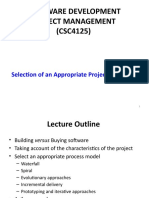0 ratings0% found this document useful (0 votes)
2 viewslecture 3
The document discusses outsourcing and various sources of software available to organizations, including IT services firms, packaged software producers, and cloud computing. It outlines criteria for evaluating off-the-shelf software, such as cost, functionality, and vendor support. Additionally, it highlights the importance of software reuse in development, presenting different approaches to facilitate this practice.
Uploaded by
Alfred MachinyaCopyright
© © All Rights Reserved
Available Formats
Download as DOCX, PDF, TXT or read online on Scribd
0 ratings0% found this document useful (0 votes)
2 viewslecture 3
The document discusses outsourcing and various sources of software available to organizations, including IT services firms, packaged software producers, and cloud computing. It outlines criteria for evaluating off-the-shelf software, such as cost, functionality, and vendor support. Additionally, it highlights the importance of software reuse in development, presenting different approaches to facilitate this practice.
Uploaded by
Alfred MachinyaCopyright
© © All Rights Reserved
Available Formats
Download as DOCX, PDF, TXT or read online on Scribd
You are on page 1/ 3
Introduction
Various sources of software are available for organizations.
Criteria exist to evaluate software from different sources.
Systems Acquisition: Outsourcing
Outsourcing: Turning over responsibility of some or all of an
organization's information systems applications and operations to
an outside firm.
Examples: Companies running payroll applications for clients or
hosting applications on-site.
Reasons to Outsource
Cost-effectiveness
Economies of scale
Freeing up internal resources
Reducing time to market
Increasing process efficiencies
System development as a non-core activity
Sources of Software
1. Information Technology (IT) Services Firms:
o Develop custom information systems for internal use.
o Host and run applications for customers.
o Provide other services.
2. Packaged Software Producers:
o Serve many market segments with broad-based and niche
packages.
o Software runs on all sizes of computers.
o Prepackaged software meets about 70% of organizations'
needs.
3. Enterprise Solutions Software:
o Enterprise Resource Planning (ERP) systems integrate
business functions into modules for seamless transactions.
o Leading vendor: SAP AG.
4. Cloud Computing:
o Provision of computing resources over the Internet.
o Customers do not need to invest in computing infrastructure.
5. Open Source Software:
o Freely available, including source code.
o Developed by a community.
o Examples: Linux, mySQL, Firefox.
6. In-House Development:
o Systems developed by the organization's own staff if expertise
exists.
o Hybrid solutions with purchased and in-house components are
common.
Selecting Off-the-Shelf Software
Cost: Compare in-house development vs. purchasing/licensing.
Functionality: Tasks the software can perform and desired
features.
Vendor Support: Level and cost of support provided.
Viability of Vendor: Adaptability to changes in systems software
and hardware.
Flexibility: Ease of customization.
Documentation: Quality and currency of user and technical
documentation.
Response Time: Speed of software response to user requests.
Ease of Installation: Difficulty of loading and making software
operational.
Validating Purchased Software Information
Use vendor proposals, software documentation, technical marketing
literature, and feedback from other users.
Request for Proposal (RFP)
Document provided to vendors to propose hardware and system
software.
Sometimes called Request for Quote (RFQ).
Use various information sources to select the best candidates.
Reuse in Software Development
Reuse: Using previously written software resources in new
applications.
Object-Oriented Development: Reuse of object classes.
Component-Based Development: Assembly of applications from
various components.
Approaches to Reuse
1. Ad-hoc: Individuals find or develop reusable assets on their own.
2. Facilitated: Developers are encouraged to practice reuse.
3. Managed: Development, sharing, and adoption of reusable assets
are mandated.
4. Designed: Assets are mandated for reuse as they are designed for
specific applications.
Summary
Outsourcing and various software sources were discussed.
Criteria for evaluating off-the-shelf software were explained.
The role of reuse in software development was highlighted.
You might also like
- Modern Systems Analysis and Design: The Origins of SoftwareNo ratings yetModern Systems Analysis and Design: The Origins of Software38 pages
- Modern Systems Analysis and Design: The Origins of SoftwareNo ratings yetModern Systems Analysis and Design: The Origins of Software36 pages
- Modern Systems Analysis and Design: The Origins of SoftwareNo ratings yetModern Systems Analysis and Design: The Origins of Software25 pages
- Modern Systems Analysis and Design: The Origins of SoftwareNo ratings yetModern Systems Analysis and Design: The Origins of Software25 pages
- Modern Systems Analysis and Design: The Sources of SoftwareNo ratings yetModern Systems Analysis and Design: The Sources of Software39 pages
- The Origins of Software: © 2008 by Prentice HallNo ratings yetThe Origins of Software: © 2008 by Prentice Hall39 pages
- Unit 1 Chapter 2 The Origins of Software 2No ratings yetUnit 1 Chapter 2 The Origins of Software 238 pages
- METHODOLOGY OF INFORMATION SYSTEMS DEVELOPMENT-SUMMARYNo ratings yetMETHODOLOGY OF INFORMATION SYSTEMS DEVELOPMENT-SUMMARY69 pages
- Chapter 9 - Selecting The Best Alternative Design StrategyNo ratings yetChapter 9 - Selecting The Best Alternative Design Strategy14 pages
- There are several alternatives for software acquisition depending on the needs and requirements of the organizationNo ratings yetThere are several alternatives for software acquisition depending on the needs and requirements of the organization1 page
- Software Development Project Management (CSC4125) : Selection of An Appropriate Project ApproachNo ratings yetSoftware Development Project Management (CSC4125) : Selection of An Appropriate Project Approach66 pages
- Modern Systems Analysis and Design: Learning ObjectivesNo ratings yetModern Systems Analysis and Design: Learning Objectives19 pages
- Systems Analysis and Design, 10 Edition Scott Tilley and Harry RosenblattNo ratings yetSystems Analysis and Design, 10 Edition Scott Tilley and Harry Rosenblatt56 pages
- Systems Analysis and Design 10 Edition: Development StrategiesNo ratings yetSystems Analysis and Design 10 Edition: Development Strategies41 pages
- Software Testing Interview Questions You'll Most Likely Be AskedFrom EverandSoftware Testing Interview Questions You'll Most Likely Be AskedNo ratings yet
- Basics of Programming: A Comprehensive Guide for Beginners: Essential Coputer Skills, #1From EverandBasics of Programming: A Comprehensive Guide for Beginners: Essential Coputer Skills, #1No ratings yet
- The Origins of Software: Jeffrey A. Hoffer Joey F. George Joseph S. ValacichNo ratings yetThe Origins of Software: Jeffrey A. Hoffer Joey F. George Joseph S. Valacich19 pages
- SAP Business Technology Platform_ Security and ComplianceNo ratings yetSAP Business Technology Platform_ Security and Compliance36 pages
- 2.+Move+fast+and+be+secure+on+AWS+cloud AWS+Builders+Online+SeriesNo ratings yet2.+Move+fast+and+be+secure+on+AWS+cloud AWS+Builders+Online+Series27 pages
- BCG Shifting Skills Moving Targets and Remaking The Workforce May 2022No ratings yetBCG Shifting Skills Moving Targets and Remaking The Workforce May 202244 pages
- Pronto Xi 760 - Foundation - Pront Connect API PlatformNo ratings yetPronto Xi 760 - Foundation - Pront Connect API Platform6 pages
- Cloud Computing (IT-318) Course Outline PDFNo ratings yetCloud Computing (IT-318) Course Outline PDF3 pages
- B360 July2023 (SAP) ExtensionForCustomer360 enNo ratings yetB360 July2023 (SAP) ExtensionForCustomer360 en89 pages
- Expert Veri Ed, Online, Free.: Custom View Settings Question #57No ratings yetExpert Veri Ed, Online, Free.: Custom View Settings Question #572 pages
- (Ebook) IT Infrastructure: Security and Resilience Solutions by Ralf Süß ,Yannik Süß ISBN 9798868800771, 8868800772 - Quickly download the ebook to start your content journey100% (1)(Ebook) IT Infrastructure: Security and Resilience Solutions by Ralf Süß ,Yannik Süß ISBN 9798868800771, 8868800772 - Quickly download the ebook to start your content journey46 pages
- Computer-Basics Gcf-Understanding The CloudNo ratings yetComputer-Basics Gcf-Understanding The Cloud2 pages
- Abhinesh Pareek - Principal Member of Technical StaffNo ratings yetAbhinesh Pareek - Principal Member of Technical Staff2 pages
- Microsoft Azure HIPAA Implementation Guide July2015100% (2)Microsoft Azure HIPAA Implementation Guide July20157 pages
- Change Order Status Is Still Pending Approval Despite The Approval Task Being CompletedNo ratings yetChange Order Status Is Still Pending Approval Despite The Approval Task Being Completed5 pages

























































































